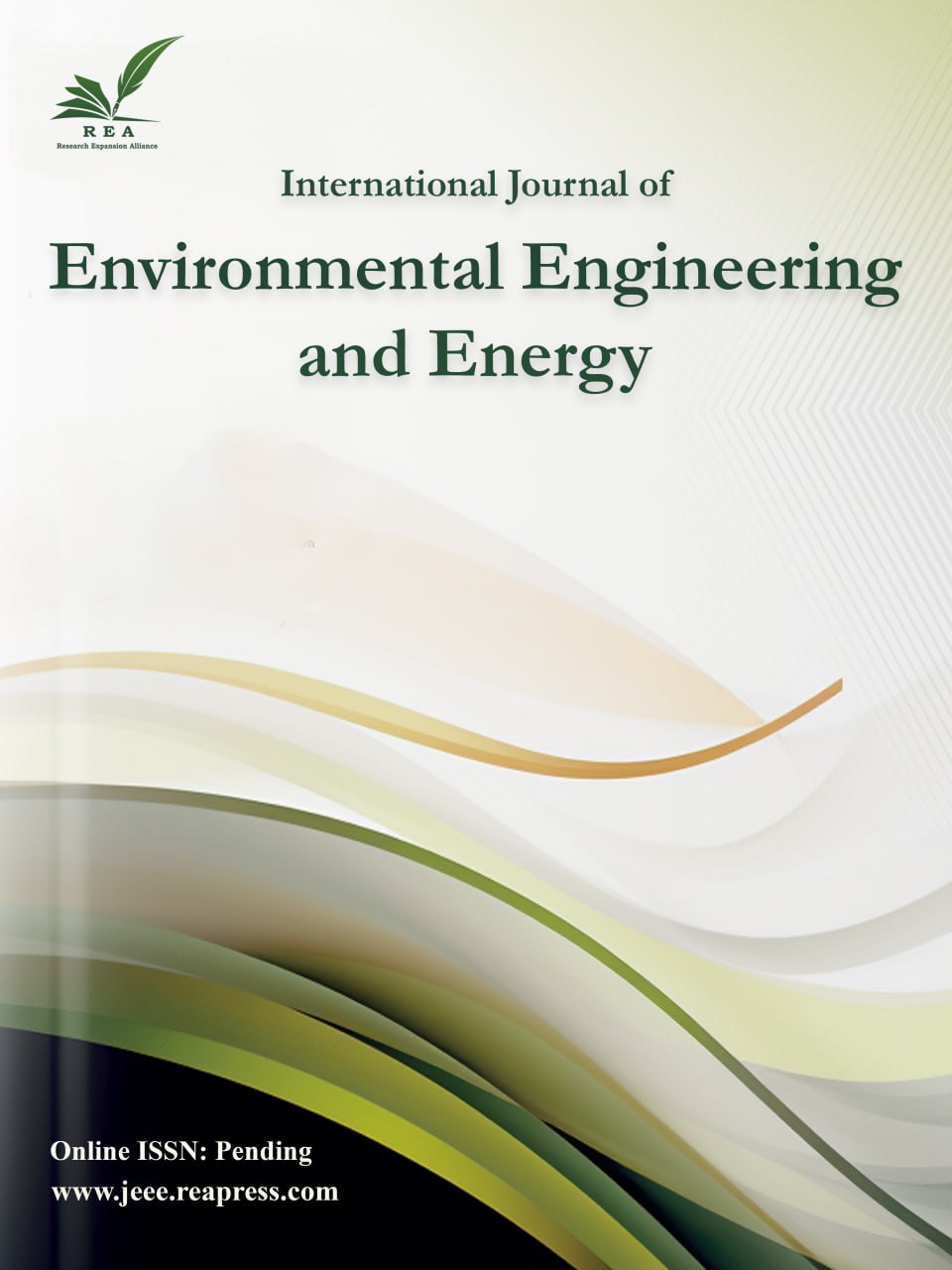Exergy-Driven Optimization of Ammonia as a Sustainable Cooling Agent for Water-Constrained Power Systems
Abstract
The present study investigates the exergy analysis of an ammonia-based cooling system for combined cycle power plants as an alternative to conventional methods using water. The study, in particular, looks at the influences of ammonia on exergy change and environmental advantages by using ammonia as a substitute for water in the cooling system. Its lower boiling point and higher latent capacity make it an attractive alternative, especially in water-scarce regions. The performances of ammonia-based systems are compared with those of water-cooled counterparts through thermodynamic simulations and case studies. It is shown that from the ammonia-based cooling cycle, exergy losses are 27.34% less than water-cooled systems during the colder seasons, mainly due to smaller losses in other components than the condenser. On the other hand, exergy losses rise by 5.57% in warmer seasons because ammonia's efficiency drops at high temperatures due to enthalpy and entropy effects. This clearly shows that ammonia-based systems experience higher inefficiencies in warmer environments than water-cooled systems, which stamps the temperature sensitivity of ammonia in cooling applications. These findings suggest that ammonia-based cooling systems improve efficiency and significantly reduce water.
Keywords:
Exergy analysis, Ammonia, Cooling systems, Power plants, Energy efficiencyReferences
- [1] [1] Jahangiri, A., Ameri, M., Arshizadeh, S., & Alvari, Y. (2023). District heating and cooling for building energy flexibility. In Building energy flexibility and demand management (pp. 173–190). Elsevier. https://doi.org/10.1016/B978-0-323-99588-7.00008-0
- [2] [2] Kia, S., Khanmohammadi, S., & Jahangiri, A. (2023). Experimental and numerical investigation on heat transfer and pressure drop of SiO2 and Al2O3 oil-based nanofluid characteristics through the different helical tubes under constant heat fluxes. International journal of thermal sciences, 185, 108082. https://doi.org/10.1016/j.ijthermalsci.2022.108082
- [3] [3] Kia, S. M., Isvand, H., & others. (2022). Numerical simulation and experimental evaluation of an unsteady flow around forced rotating cylindrical prototype with three orthogonal plates. Modares mechanical engineering, 22(11), 637–646. http://dorl.net/dor/20.1001.1.10275940.1401.22.11.1.6
- [4] [4] Ashrafi, N., Sadeghi, A., & others. (2018). Numerical simulation of visco-plastic fluid flow between two parallel plates with triangular obstacles. Bulletin of the american physical society, 63. http://meetings.aps.org/link/BAPS.2018.DFD.KP1.137
- [5] [5] Ashrafi, N., & Kia, S. M. (2018). Numerical simulation of an unsteady flow over a circular cylinder at high Reynolds numbers. Bulletin of the american physical society, 63. http://meetings.aps.org/link/BAPS.2018.DFD.D32
- [6] [6] Kia, S. M., & Talebi, F. (2018). Numerical Investigation of unsteady flow around a circular cylinder at different Reynolds numbers. 26th annual conference of mechanical engineering. https://civilica.com/doc/1134380/
- [7] [7] Kia, S. M., Nobakhti, M. H., & Khayat, M. (2020). Experimental investigation on heat transfer and pressure drop of Al2O3-base oil nanofluid in a helically coiled tube and effect of turbulator on the thermal performance of shell and tube heat exchanger. Journal of energy conversion, 7(3), 61–80. http://jeed.dezful.iau.ir/article-1-327-en.html
- [8] [8] Ikpe, A. E., Ekanem, I., & Ekanem, K. R. (2024). Conventional Trends on Carbon Capture and Storage in the 21st Century: A Framework for Environmental Sustainability. Journal of environmental engineering and energy, 1(1), 1–15. https://www.jeee.reapress.com/journal/article/view/17
- [9] [9] Shankar, R., Srinivas, T., Anand, B., Murugavelh, S., & Rivera, W. (2020). Design and analysis of cooling co-generation cycle using aqua-ammonia as working fluid. Thermal science and engineering progress, 20, 100744. https://doi.org/10.1016/j.tsep.2020.100744
- [10] [10] Bahlouli, K., Lotfi, N., & Ghadiri Nejad, M. (2023). A new multi-heuristic method to optimize the ammonia--water power/cooling cycle combined with an HCCI engine. Sustainability, 15(8), 6545. https://www.mdpi.com/2071-1050/15/8/6545
- [11] [11] Ayou, D. S., Saravanan, R., Bruno, J. C., & Coronas, A. (2013). Analysis and simulation of modified ammonia/water absorption cycle for power and cooling applications. International journal of low-carbon technologies, 8(suppl_1), i19-i26. https://doi.org/10.1093/ijlct/ctt032
- [12] [12] Braccio, S., Phan, H. T., Tauveron, N., Le Pierrès, N., & Arteconi, A. (2023). Energy, exergy and exergoeconomic analysis and optimisation of the scale-up of a combined ammonia-water absorption pilot plant producing electricity and refrigeration. Energy conversion and management, 278, 116686. https://doi.org/10.1016/j.enconman.2023.116686
- [13] [13] Al-Falahi, A., Alobaid, F., & Epple, B. (2020). Thermo-economic evaluation of aqua-ammonia solar absorption air conditioning system integrated with various collector types. Entropy, 22(10), 1165. https://www.mdpi.com/1099-4300/22/10/1165
- [14] [14] Wilson, E. O., Jerry, E. P., & others. (2024). Temperature effects on the corrosion inhibition of mild steel in crude oil medium by the seed extract of persea americana (Avocado Tree). Journal of environmental engineering and energy, 1(1), 16–23. https://jeee.reapress.com/journal/article/view/21
- [15] [15] Ahmadi, G. R., & Toghraie, D. (2016). Energy and exergy analysis of Montazeri steam power plant in Iran. Renewable and sustainable energy reviews, 56, 454–463. https://doi.org/10.1016/j.rser.2015.11.074
- [16] [16] Yuan, H., & Mei, N. (2015). Energy, exergy analysis and working fluid selection of a Rankine cycle for subsea power system. Energy conversion and management, 101, 216–228. https://doi.org/10.1016/j.enconman.2015.05.043
- [17] [17] Mehrpooya, M., Dehghani, H., & Moosavian, S. M. A. (2016). Optimal design of solid oxide fuel cell, ammonia-water single effect absorption cycle and Rankine steam cycle hybrid system. Journal of power sources, 306, 107–123. https://doi.org/10.1016/j.jpowsour.2015.11.103
- [18] [18] Pacheco-Reyes, A., Jiménez-García, J. C., Hernández-Magallanes, J. A., Shankar, R., & Rivera, W. (2024). Energy, exergy, and economic analysis of a new system for simultaneous power production and cooling operating with an ammonia–water mixture. Processes, 12(7), 1288. https://doi.org/10.3390/pr12071288
- [19] [19] Jiménez-García, J. C., & Rivera, W. (2023). Exergy analysis of an experimental ammonia/water absorption cooling system. Case studies in thermal engineering, 49, 103167. https://doi.org/10.1016/j.csite.2023.103167
- [20] [20] Dincer, I., & Rosen, M. A. (1999). Energy, environment and sustainable development. Applied energy, 64(1–4), 427–440. https://doi.org/10.1016/S0306-2619(99)00111-7
- [21] [21] Srivastava, A., & Maheshwari, M. (2021). Energy, exergy and economic analysis of ammonia-water power cycle coupled with trans-critical carbon di-oxide cycle. Journal of thermal engineering, 10(3), 599–612. https://doi.org/10.14744/thermal.0000823
- [22] [22] Ubabuike, U. H., Ime, J. U., Anosike, A. C., & Wilson, E. O. (2024). Comparative performance study of kolanut biodiesel and conventional fossil diesel. Journal of environmental engineering and energy, 1(1), 24–31. https://jeee.reapress.com/journal/article/view/23
- [23] [23] Saedi, A., Jahangiri, A., Ameri, M., & Asadi, F. (2022). Feasibility study and 3E analysis of blowdown heat recovery in a combined cycle power plant for utilization in Organic Rankine Cycle and greenhouse heating. Energy, 260, 125065. https://doi.org/10.1016/j.energy.2022.125065
- [24] [24] World, B. (2020). Water Management in Thermal Power Plants. , World Bank Group.
- [25] [25] Arshizadeh, S., Khanmohammadi, S., Jahangiri, A., Sajedi, S. M. H., Panchal, H., Prakash, C., & Gupta, N. K. (2024). Thermodynamic modeling and multi-objective optimization of an operating double-effect absorption chiller driven by photovoltaic panel: a case study. Journal of environmental engineering and energy, 1(1), 32–46. https://jeee.reapress.com/journal/article/view/22
- [26] [26] Hosseinizadeh, S. E., Majidi, S., Goharkhah, M., & Jahangiri, A. (2021). Energy and exergy analysis of ferrofluid flow in a triple tube heat exchanger under the influence of an external magnetic field. Thermal science and engineering progress, 25, 101019. https://doi.org/10.1016/j.tsep.2021.101019
- [27] [27] Jahangiri, A., Farahani, M. E. S., Ahmadi, G., Shahsavar, A., Borzouei, A., & Gharehbaei, H. (2022). Coupled CFD and 3E (Energy, Exergy and Economical) analysis of using windbreak walls in heller type cooling towers. Journal of cleaner production, 358, 131550. https://doi.org/10.1016/j.jclepro.2022.131550
- [28] [28] Shahsavar, A., Jahangiri, A., Ahmadi, G., & others. (2022). Energy and exergy analysis and multi-objective optimization of using combined vortex tube-photovoltaic/thermal system in city gate stations. Renewable energy, 196, 1017–1028. https://doi.org/10.1016/j.renene.2022.07.057
- [29] [29] Alihosseini, N., Jahangiri, A., & Ameri, M. (2024). Energy, exergy, exergoeconomic, and exergoenvironmental analyses and multi-objective optimization of parallel two-stage compression on the domestic refrigerator-freezer. International journal of air-conditioning and refrigeration, 32(1), 1–15. https://link.springer.com/content/pdf/10.1007/s44189-024-00054-y.pdf
- [30] [30] Dezfouli, A. H. M., Arshizadeh, S., Bakhshayesh, M. N., Jahangiri, A., & Ahrari, S. (2024). The 4E emergy-based analysis of a novel multi-generation geothermal cycle using LNG cold energy recovery. Renewable energy, 223, 120084. https://doi.org/10.1016/j.renene.2024.120084
- [31] [31] Jahangiri, A., Yahyaabadi, M. M., & Sharif, A. (2019). Exergy and economic analysis of using the flue gas injection system of a combined cycle power plant into the Heller Tower to improve the power plant performance. Journal of cleaner production, 233, 695–710. https://doi.org/10.1016/j.jclepro.2019.06.077
- [32] [32] Ahmadi, G., Jahangiri, A., & Toghraie, D. (2023). Design of heat recovery steam generator (HRSG) and selection of gas turbine based on energy, exergy, exergoeconomic, and exergo-environmental prospects. Process safety and environmental protection, 172, 353–368. https://doi.org/10.1016/j.psep.2023.02.025


